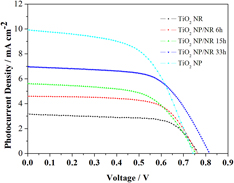Crossref Citations
This article has been cited by the following publications. This list is generated based on data provided by
Crossref.
Tan, Xin-Yu
Sun, Lei
Zhang, Guo-Rong
Deng, Can
Tu, Yi-Teng
and
Guan, Li
2019.
Absorption Enhancement of Ultrathin Crystalline Silicon Solar Cells with Dielectric Si3N4 Nanostructures*.
Communications in Theoretical Physics,
Vol. 71,
Issue. 11,
p.
1346.
Mustafa, Muhammad Norhaffis
and
Sulaiman, Yusran
2020.
Fully flexible dye-sensitized solar cells photoanode modified with titanium dioxide-graphene quantum dot light scattering layer.
Solar Energy,
Vol. 212,
Issue. ,
p.
332.
Wei, Liguo
Wu, Qinhang
Yang, Yongsheng
Jiang, Bo
Sun, Gonglei
Feng, Jing
Yu, Furong
Kang, Yu
and
Dong, Guohua
2020.
One-step synthesis of nitrogen-decorated CeO2/reduced graphene oxide nanocomposite and its electrocatalytic activity for triiodide/iodide reduction.
Journal of Materials Research,
Vol. 35,
Issue. 11,
p.
1461.
Sayahi, Hani
Aghapoor, Kioumars
Mohsenzadeh, Farshid
Mohebi Morad, Mina
and
Darabi, Hossein Reza
2021.
TiO2 nanorods integrated with titania nanoparticles: Large specific surface area 1D nanostructures for improved efficiency of dye-sensitized solar cells (DSSCs).
Solar Energy,
Vol. 215,
Issue. ,
p.
311.
Lv, Chunmei
Wang, Xiuwen
Li, Qun
Li, Chunyan
Ouyang, Qiuyun
Liu, Yongjun
and
Qi, Lihong
2021.
Template-assisted synthesis of porous TiO2 photoanode for efficient dye-sensitized solar cells.
Journal of Materials Research,
Vol. 36,
Issue. 3,
p.
688.
Atli, Aycan
and
Yildiz, Abdullah
2022.
Hybrid TiO2 Nanorods Combined with a Buffer Layer for Dye-Sensitized Solar Cells.
Applied Solar Energy,
Vol. 58,
Issue. 3,
p.
323.
Ezike, Sabastine C.
Ahmed, Abubakar D.
Obodo, Raphael M.
and
Salawu, Mufutau A.
2022.
Perovskite precursor concentration for enhanced recombination suppression in perovskite solar cells.
Hybrid Advances,
Vol. 1,
Issue. ,
p.
100006.
Nithya, P.
Roumana, C.
Velraj, G.
Balasubramanian, V.
Shkir, Mohd.
and
Reddy, Vasudeva Reddy Minnam
2022.
Biomass-derived carbon (BC) modified CoWO4 nanoparticles composites for improved performance of dye-sensitized solar cells.
Chemical Physics Letters,
Vol. 803,
Issue. ,
p.
139814.
Shobana, M.
Balraju, P.
Senthil Kumar, P.
Muthukumarasamy, N.
Yuvakkumar, R.
and
Velauthapillai, Dhayalan
2022.
Investigation on the performance of nanostructure TiO2 bi-layer as photoanode for dye sensitized solar cell application.
Sustainable Energy Technologies and Assessments,
Vol. 52,
Issue. ,
p.
102295.
Hou, Yike
Mushtaq, Asim
Tang, Zhe
Dempsey, Eithne
Wu, Yuling
Lu, Yuguang
Tian, Cong
Farheen, Jabeen
Kong, Xiangdong
and
Iqbal, M. Zubair
2022.
ROS-responsive Ag-TiO2 hybrid nanorods for enhanced photodynamic therapy of breast cancer and antimicrobial applications.
Journal of Science: Advanced Materials and Devices,
Vol. 7,
Issue. 2,
p.
100417.
Arla, Sai Kumar
Konidena, Naga Sathya Sai
Sana, Siva Sankar
Godlaveeti, Sreenivasa Kumar
and
Boya, Vijaya Kumar Naidu
2022.
Structural and morphological effect of multidimensional TiO2 nanostructures on the dye-sensitized solar cells performance.
Sādhanā,
Vol. 47,
Issue. 3,
Naveenkumar, N.
Abhishek, A.
Sridevi, D. V.
Balu, Murali
Neppolian, B.
and
Ramesh, V.
2023.
Size-dependent structural, morphological, optical, and electrical studies of hydrothermally synthesized TiO2 nanocorals for DSSC application.
Journal of Materials Science: Materials in Electronics,
Vol. 34,
Issue. 32,
Wu, Dongda
Wang, Yi
Xiao, Jiamin
Hu, Jiang
Zhao, Xuchao
Gao, Yuhao
Yuan, Jiazhi
and
Wang, Wenxin
2023.
Surface lattice resonances enhanced directional amplified spontaneous emission on plasmonic honeycomb nanocone array.
Physical Chemistry Chemical Physics,
Vol. 25,
Issue. 39,
p.
26847.
Wante, Haruna P.
Aidan, Joseph
and
Ling, Yap S.
2024.
Highly improved efficiency of flexible dye sensitized solar cells (DSSCs) by non-thermal plasma processing of PEI-ITO polymer.
Optical Materials,
Vol. 150,
Issue. ,
p.
115331.
Lana, Gbemiga Matthias
Bello, Ismaila Taiwo
Adedokun, Omonike Mary
Adenigba, Victoria Olaide
Jubu, Peverga Rex
Adedokun, Oluwaseun
Sanusi, Yekinni Kolawole
Dhlamini, Mokhotjwa Simon
and
Awodugba, Ayodeji Oladiran
2024.
One-Dimensional TiO2 Nanocomposite-based Photoanode for Dye-Sensitized solar Cells: A review.
Solar Energy,
Vol. 279,
Issue. ,
p.
112850.


